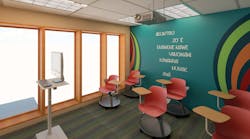The Interior Design Educators Council (IDEC) offers an opportunity for student designers to shine in its annual Student Design Competition. The 2017 challenge was “Design as an Agent of Social Change,” with a focus on the Amazon rainforest, indigenous populations, and the role of education and service learning in preservation efforts. Participants were to consider how their concepts represented the power of research and evidence-based design in a global context.
Students were asked to design the interior of a 3,700-square-foot educational facility located near Miami. The site is intended to “serve as the rientation and educational space for individuals embarking on a service-learning trip to the Amazon Basin of South America. Images, natural materials, and cultural context of the area are required in order to strongly relate service-learning participants to their destination which could be any one of the nine nations with claim to the Amazon rainforest.”
First-place winners from the graduate level, Gabriela Fonseca Pereira and Stormy Hill, both students at Oklahoma State University, were recognized for their concept titled, “H2GO.” During their Fall 2016 semester they were enrolled in Interior Design Studio, and the entire class participated in the competition. The challenge hit close to home for Fonseca Pereira, who came to the U.S. from Brazil to pursue her PhD in the Department of Design, Housing and Merchandising at Oklahoma State. “The opportunity to talk and advocate about the Amazon, [with] most of it located in Brazil, was an amazing personal experience,” she said. “The project description showed the IDEC organizers of the competition the worldwide importance of the Amazon. Without the Amazon, we will all suffer. An educational center would spread knowledge and awareness about the world responsibility with the Amazon rainforest.”
Because of the importance of water for rainforest life, Fonseca Pereira and Hill made the natural element central in their concept with a “wave wall” in the middle of the floor plan. “[Fonseca Pereira] is from Brazil and was very knowledgeable about the experiences that the indigenous peoples were having and the impact of the dams on the flora and fauna in the area,” Hill said. “We decided to base our concept on the one thing that was essential to both the indigenous peoples and the environment of the Amazon rainforest which is the river. Our facility was meant to provide its users with the same educational sustenance that the rivers physically provide for the Amazon rainforest.”
While Hill’s dream is to eventually become an educator, Fonseca Pereira plans to continue working with interior design, research, and teaching “in order to make better products and environments for the older adult population, which is increasing around the world.
“I believe that if we design being aware of older adults' needs, we will be designing for the needs of the entire population,” she continued. “The teaching aspect [spreads] awareness for future generations about the needs when designing for older adults.”
For the undergraduate level, a team of three students captured the first-place award with the concept they called, “COMÚN.” Sarah d'Artois, Catherine Yuen, and William Chen participated in the competition via the Interior Design program at British Columbia Institute of Technology (BCIT) in Burnaby, British Columbia, Canada, which has been involved in the IDEC Student Design Competition since 2010. “Our program heads incorporate the competition into our fall curriculum, using it as our fall final term project in second and third year,” Yuen explained. “We complete the work in teams in the allotted time, and a panel of instructors review the submissions and select the top three to be put forward to regionals.”
With two weeks to complete the design process, the undergraduate team spent the first week fine-tuning its concept and the direction it wanted to take in terms of conducting thorough research and creating bubble diagrams. The second week was for space planning, continuing research, and finalizing graphics and presentation boards for submission.
“We had a strong concept to work with that was related to the competition outline,” Yuen said. “I had seen a documentary in early 2016 about the quipu [a historical South American recording device] and kept the idea for a project inspiration in my back pocket—it was perfect.”
With that, Yuen, d’Artois, and Chen carried out extensive research to develop a proposal identifying new trends for service learning in the 21st century, in addition to conducting an in-depth location analysis. “We put an emphasis on understanding the current environmental issues threatening the stability of the Amazon rainforest, and educating ourselves on dual subject-matter learning environments,” Yuen explained. “Through the design process, we integrated this knowledge into the programming and design of the facility with reconfigurable spaces and design features such as bio-metric lighting controls.”
Design elements in the space that connect to the inspiration from South American culture include various lines, specifically curved lines for quipu; vertical lines for the rainforest; and open sight lines through connecting space. Circular seating, curved wall installation, and circular/curved form in ceiling details are included in the team’s concept as well, in addition to bold, natural colors and textures typical to the Amazon region and inspired by quipu. As described in the project, “the connected layout of workspaces reflects the form and intent of the quipu by connecting small-group and large-group collaboration zones through open sight lines, tying the spaces together. ...Reconfiguration flexibility allows for a seamless transition between lecture-style and campfire seating, providing dual subject-matter learning environments ideal to 21st century education spaces.”
Going forward, the students plan to continue to build up their interior design portfolios, on both the commercial and residential sides of the business. “I chose interior design as a career path so that I could engage with both my desire to help and improve the lives of others and my creative right side of the brain, and am very excited to be fully involved in the industry,” Yuen noted.
For information about the 2017-2018 IDEC Student Design Competition, visit idec.org.


